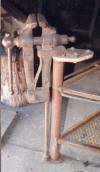The Blacksmith's Leg Vise
[Home] [Buying
Tools] [Setting
Up Shop] [Anvils]
[Tongs] [Legvise]
[Blacksmith
Tools For Sale] [Air
Hammers] [Mechanical
Hammers]
UPDATED September 17, 2019.


 Leg vise (Post vise).
The leg vise is named for its characteristic leg which extends from its rear
jaw all the way to the floor. The leg vise is the blacksmith's vise of choice
because the leg mounted below the vise offers extra stability and rigidity for
the work while it is being pounded in the vise.
Leg vise (Post vise).
The leg vise is named for its characteristic leg which extends from its rear
jaw all the way to the floor. The leg vise is the blacksmith's vise of choice
because the leg mounted below the vise offers extra stability and rigidity for
the work while it is being pounded in the vise.
The vise can be mounted to tree stump, post, or work bench. The vise
is mounted to either a tree stump placed in the floor, or to a wooden work bench
or a steel bench with a wooden shim between the mounting plate of the vise and
the steel table. Never mount the leg vise to a concrete or steel bench without a
thick wooden shim between them or the mounting bolts will quickly be worn out or
pulled out due to concussion. I mounted a large vise to a concrete post
years ago and it took 1 day of work to loosen the bolts and destroy the holes.
The mounting bracket on the rear of the vise can be adjusted vertically
approximately 2 or 3 inches to fit the height of the bench or stump.
An open and unobstructed location is needed for the legvise. Place the
vise in an area of the shop that allows open access all around the vise for at
least several feet. Keep in mind that you may be placing long bars in the jaws
of this vise so that the bars extend for a long distance sideways from the vise
(parallel with the jaws). You will want room around this vise for working and
maneuvering tools. A wide open path from the forge to this vise is needed to
allow long bars to be moved from the fire to the vise without obstructions. The
bench or stump must stand solid without wiggling during work. A wiggling vise is
annoying and may interfere with work. The photo above left shows this vise
mounted to a steel 3-legged bench with a wood shim to absorb concussion between
the vise and bench. This bench is counterweighted with a water barrel and a
large set of tool racks (later filled full with tongs and hammers and clamps).
Attention when adjusting the mounting bracket. The mounting bracket on the leg vise is secured to the
middle of the rear
jaw with a pair of wedges. Loosen the wedges and the mounting plate will slide
up or down several inches to accommodate different bench or stump heights. Be
alert when re-tightening the wedges because the jaw spring is also fastened with
mounting bracket inside the space between the jaws . Test the new mounting
bracket position after lightly tightening the wedges to be sure the new position
of the jaw spring will work without binding. Open the screw
completely and work the open and closed fully in both directions to make sure
the new height setting on the mount plate has not interfered with the action of
the spring or caused it to jam against the lower hinge of the front vise jaw.
The spring can usually be moved up or down inside the mounting bracket to
accommodate different mount heights without jamming. With the action of the
spring set up properly and the mounting bracket height set for the bench or
stump, finish tightening the assembly.
Clean the screwbox when first placing the vise in service. The screw
and box often are found with excessive dirt and dried grease in the threads.
Remove and disassemble the screw assembly. Use penetrating oil or kerosene.
Thoroughly clean the threads of both the screw and inside the box. Apply grease
to the screw thread and reinstall.
Buying used legvises at flea markets. For a beginner at least one is
needed. Later the smith will need 2 or 3. Whatever you can find as long as the
jaws are at least 4 inches wide or larger. 5 inch wide jaws make a nice
intermediate size that will be used forever. Jaws line up evenly!
Bent screw handles can be straightened and so can bent legs. But stay away from
bent or broken jaws or broken or bent screws. Those cannot be repaired properly.
Prices vary considerably. I never pay more than $60 for a good legvise and even then it had better be a good one. Most I picked up for $12 to
$40. Later on the smith may find really nice ones they would pay more money for
at blacksmith shops that are being auctioned. I have seen good ones go for as
high as $285. These are really special cases and these same vises are seldom
found at flea markets. Note for new smiths: these vises common and easy to find.
Don't rush to buy a junk vise just because the seller tells you that there vise
it rare or one of the last left for sale. There are many of these vises for sale
and lots of good ones trading owners every day.
Updated on:
17 September, 2019.

Page created on:
17 September 2019.
 Leg vise (Post vise).
The leg vise is named for its characteristic leg which extends from its rear
jaw all the way to the floor. The leg vise is the blacksmith's vise of choice
because the leg mounted below the vise offers extra stability and rigidity for
the work while it is being pounded in the vise.
Leg vise (Post vise).
The leg vise is named for its characteristic leg which extends from its rear
jaw all the way to the floor. The leg vise is the blacksmith's vise of choice
because the leg mounted below the vise offers extra stability and rigidity for
the work while it is being pounded in the vise.